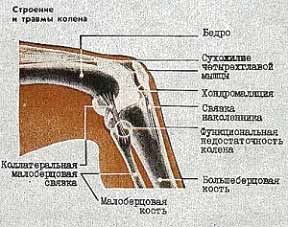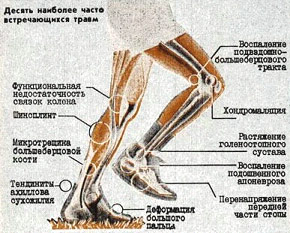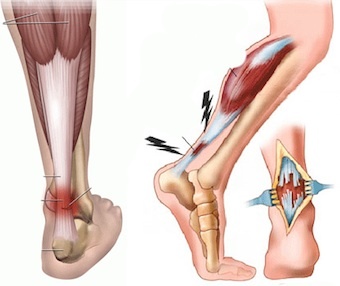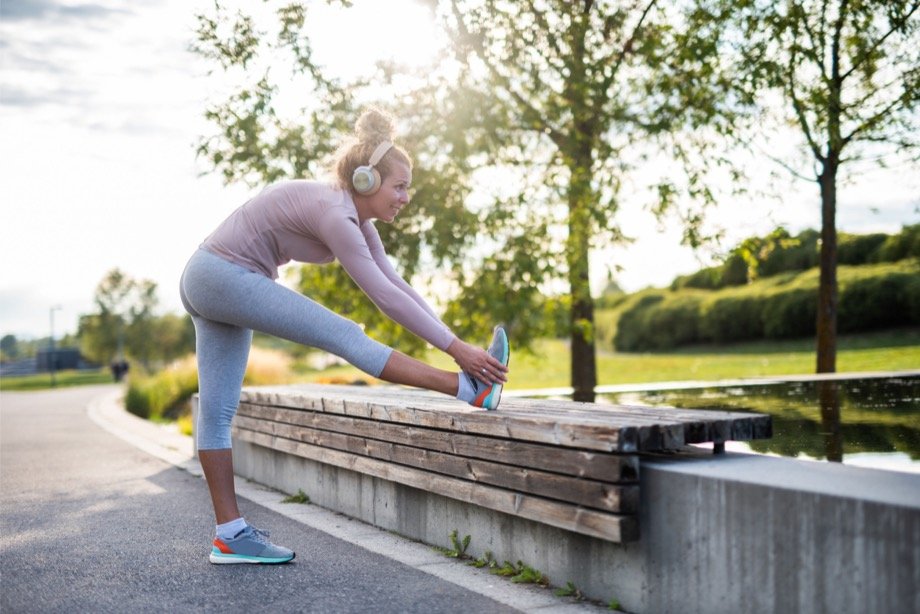PRECAUTIONS
If you have signs of Achilles tendonitis, you should stretch before and after every workout.
If symptoms of inflammation occur, use ice, anti-inflammatory medications, moderate walking, or rest for a few days until the pain subsides. In the evening, you should perform moist heat treatments to promote blood circulation to the injured area. In more severe cases, complete rest is required.

- Why your feet hurt after running and what you can do about it
- Causes of foot pain after running
- Sporty element
- 3 Tibiofibular Ligament Syndrome (TTS)
- 4 Periostitis of the shinbone (inflammation of the periosteum)
- Hamstring tendon injury (hamstring syndrome)
- Achilles tendinitis
- Is it possible to avoid running injuries?
- Stress fracture
- The five most common injuries
- Knee pain during/after running
- The 5 most interesting facts about runner's knees
- Why running can damage your knees
- Knee injuries
- Knee injuries caused by improperly fitting running shoes
- Spinal injuries
- Sports injuries to the spine
Why your feet hurt after running and what you can do about it
Foot pain after running can occur for many reasons. Here are just a few of the running injuries you've probably heard of: periotitis, stress fractures, 'runner's knee', Achilles tendonitis and blisters. Runners with injuries are not uncommon: the vast majority of athletes are injured at some point in their running careers.
This article explains why feet hurt after running, what the causes are and how you can prevent them.
Causes of foot pain after running
The main cause of foot pain after running is often delayed pain syndrome. Such pain is certainly not avoided by someone who is running for the first time or by a runner who has subjected their legs to something very unusual, such as: B. a long run downhill.
Muscle soreness usually begins the day after activity and peaks after 24 to 48 hours before subsiding over the following days. The cause of the pain is simple and clear: small tears form in the muscle tissue due to unusual physical exertion.
This leads to a normal inflammatory response in which fluid accumulates outside the muscle cells and pressure within the tissue gradually increases. This pressure soon reaches a level that stimulates the nerve endings and pain occurs. It lasts about 48 hours, after which the damaged tissue regenerates and the pain subsides.
To avoid delayed pain, warm up by running and walking slowly and do some stretching exercises after exercise. It must be said that these measures do not necessarily prevent the pain if it is a serious muscle injury.
But what about other injuries? Why do they occur? The vast majority of injuries are caused by overloading the legs - it's as simple as that. The tissue reacts to a load that it cannot handle with inflammation.

- Incorrect running technique.
- The strain is greater than what your body can previously handle. The slower you increase your weekly mileage and intensity, the less likely you are to injure yourself.
- Inadequate rest and malnutrition.
- Lack of warm-up before training.
- Unsuitable running shoes or incorrectly chosen running shoes.
- Individual foot conditions (flat feet, excessive pronation, etc.).
- Running on hard surfaces.
- Uneven distribution of vertical load on the musculoskeletal system due to significant body asymmetry;
- Muscular imbalance due to lack of strength and general fitness.
Sporty element

Renowned American specialists John Pagliano and Doug Jackson have conducted extensive clinical studies to identify the nature of various running injuries and the causes that trigger them. Over a period of ten years, they studied 3,273 injured runners of varying fitness, from cross-country skiers to Olympic champions, and analyzed more than 40 characteristics of injured athletes (age, gender, weight, leg structure, injury conditions, footwear, training methods, etc.), then gave all entered this information into a computer and identified the most common causes, characteristics and symptoms of injuries.
It turns out that there are 'female' and 'male' injuries. The most common injuries in men are plantar aponeurosis, Achilles tendonitis and functional failure of the knee joint, while in women they are periotitis and 'runner's knee'. Runners over 40 are at higher risk of back and foot injuries.
Here are some other trends that emerged: Light-running runners (less than 20 miles (32 km) per week) were 46 % more likely to be injured; the majority of the injured (66 %) only completed long, slow runs, while the remaining 34 % included some form of speed training; almost all (90 %) performed regular stretching exercises before and after the run; Beginners (14.0 %) were less likely to be injured than runners with more than two years of running experience (38 %); Men were twice as likely to be injured as women.
Of all the injuries, the authors identified the 10 most common and five causes of injuries. 1. excessive volume, intensity of training, rapid increase in workload. 2. running on surfaces that are too hard, hilly or uneven 3. weak, inflexible muscles. Running in unsuitable footwear, 5. Defects in the foot structure.
These are the 10 most common injuries among runners.
PLANTAR TENDON INFLAMMATION (PLANTAR APONEUROSIS)
Plantar aponeurosis (PAP) is a thickening of fascia, a bundle of fibrous tissue that runs along the edge of the foot from the heel bone to the toes and supports the arch of the foot so that it does not flatten under the weight of the body. If the plantar tendon is inflamed, running is painful at best.
3 Tibiofibular Ligament Syndrome (TTS)
–> –>
The iliotibial band is a long piece of connective tissue that runs from the outside of the thigh to the knee. It helps stabilize the knee when walking or running.
TTS is caused by the repeated friction of the connective tissue on the leg bone. Weak gluteal, abdominal, or hip muscles can also contribute to this condition.
It is usually accompanied by a stabbing pain on the outside of the leg, usually just above the knee. The symptoms often worsen when the knee is bent.
4 Periostitis of the shinbone (inflammation of the periosteum)
Periostitis is pain that occurs in the outer or inner part of the shinbone, along the shinbone. Shin periostitis provokes running too fast, especially when running on hard surfaces.
In most cases, shin periostitis is not serious and will resolve itself after rest. However, if you ignore them and continue to exercise, you risk suffering a fracture.
- Dull pain on the outside or inside of the shinbone;
- pain that increases with exercise;
- The shinbone is sensitive to touch;
- slight swelling.
Hamstring tendon injury (hamstring syndrome)
Hamstrings are the muscles of the back group of the thigh. Sudden movements and changes in direction often lead to injuries and stretches of these muscles. It is important to choose the right load so as not to stress them constantly, and to stretch and gradually strengthen them while running, during sudden stops and changes of direction.

- Strengthening the hamstring muscle groups in combination with stretching
- physical therapy
- Medical therapy
- Manual techniques
Achilles tendinitis
Often affects runners due to pain in the Achilles tendon insertion: stiffness when standing on toes, pain in the morning. Caused by chronic overuse and repetitive exertion.

- Proper footwear
- Appropriate loading that includes stabilization and strengthening of the ankle and its components.
- Anti-inflammatory therapy
- Treatment with medication (if prescribed by a doctor)
- physical therapy
- There can be no talk of peace!
'If you have joint pain while exercising
start with the right training!'



Founded in 2016 © Marathon Academy Running Club,
IP Cherepanov S. OGRNIP: 316222500121635
Any use of information on this site, design elements and layout is permitted only with the permission of the rights holder and only with a link to the source: www.academymarathon.ru
Specialization: Methodology development, long-distance training, preparation for races from 1000m to marathon
Experience in dealing with recreational runners since 2015. Specialization: running technique, motivation and lecturing
In hobby running since 2014, founding of the Marathon Academy in 2016. Has completed 9 marathon distances, including one of the most iconic marathons in the world - New York 2019, with action camera in hand in 2:50
Speaker. Corporate sports projects: MTS, Johnson & Johnson, Jamilko, MIR. Author and host of a podcast about running 'Keep the pace'.
Is it possible to avoid running injuries?
No runner, even the most experienced, is immune from injury, but everyone can reduce the likelihood of injury. To do this, it is important to observe safety rules and follow the following tips:
- A warm-up training should always be carried out before training. It not only 'warms up' the muscles, but also prepares the musculoskeletal system for sporting activity, improves coordination and increases strength during movement. This also applies to swimming or Nordic walking as well as to any other sport, even the safest one.
- General fatigue of the body is a reason to postpone training until better times. Finally, your muscles are also tired, meaning they cannot compensate for the energy of hitting the ground, putting more stress on the joints.
- If you are overweight, start with walking, then progress to light jogging and gradually increase your pace. In this way, both your cardiovascular system and your musculoskeletal system are prepared for physical activity.
- Do not walk on concrete or asphalt. The best surface is a stadium track with a cushioning layer.
- Wear special sports shoes and, if your foot is deformed, additional orthopedic insoles.
How can you run for a long time, comfortably and without straining your joints? Watch the video below:
Running is a very injury-prone sport. Osteoarthritis in experienced runners is not uncommon. If you can't imagine life without this physical activity, don't rush into giving it up. Just play it safe, stay alert and pay attention to the smallest joint problems. If in doubt, you should consult a good orthopedist!
Stress fracture
This is what experts call a fracture of a thin bone or a partial fracture. Its biggest disadvantage is that it is not immediately noticeable and cannot be detected even during an ultrasound scan. The most common injury affects the shinbone, also known as the tibia. Its upper end rests on the kneecap and its lower end rests on the bones of the foot, which form the tarsus. Incidentally, it is also often susceptible to breaks and fractures.
These injuries are usually caused by high impact loads. This in turn is a result of (supposedly) stiff soles and surfaces that are too hard.
In order to prevent stress fractures, it is particularly important to warm up before training. It warms up the muscles and makes them more flexible. Stiff muscles, on the other hand, stiffen the bone and make it vulnerable to injury.
how to treat. Pain in your leg, difficulty pedaling, perhaps a little swelling - these are all sure signs that you should stop running for a while and see what's going on. You should also take a break for bruises and sprains that go away much more quickly.
If the pain persists for a week and worsens, a stress fracture should be suspected, even if it is not visible on an ultrasound scan. However, an ultrasound scan will most likely show a micro-injury to the shinbone that will need to be immobilized with a cast. In other cases, complete rest is required for a long time - up to two months - to allow the fracture to heal. In the future, you should limit running and avoid speed training on asphalt.
The five most common injuries
It could be a sprain or torn ligament.
If the area swells quickly and hurts a lot when you move, it is most likely a tear and you need to go to the hospital and have an MRI.
If the leg is not swollen but is painful, it is a sprain. Apply a cooling bandage, you can use an ointment. If the symptoms do not go away after a day, see your doctor.
First, try to choose smooth routes without visible bumps in the terrain. Treadmills with a soft rubber surface for good cushioning are ideal.
Remember to lace your shoes well from bottom to top so that your foot doesn't sag.
Include exercises to stabilize the ankle joint in your training plan - this is balance training on unstable surfaces. A competent trainer can help you with this.

Knee pain during/after running
Knee pain most often occurs when the ligaments are inflamed or the menisci are damaged. It could also be an old injury that has gotten worse or a new one caused by a bump on the leg.
There can be many causes, one of which is unsuitable running shoes. Running shoes should be lightweight, aerodynamic, breathable, and have a thick sole to absorb shock. So it's worth choosing the right jogging shoes.
Knee pain can also be caused by flat feet and being overweight. This can lead to an uneven distribution of the load on the joint and to signs of wear on individual parts of the joint.
Pay attention to your running technique. If you walk incorrectly, the load on your joints will not be evenly distributed, which can lead to injury.
The 5 most interesting facts about runner's knees
№ 1. active runners suffer from osteoarthritis less often.
Statistically speaking, runners are half as likely to develop osteoarthritis as people who don't run regularly. Scientists find it difficult to say exactly why, but they suspect that it is due to a good metabolism and a strong immune system as well as a well-developed cardiovascular system.
№ 2. Knee problems can occur at any age.
With osteoarthritis there is natural wear and tear of the cartilage tissue. It is believed that this process is particularly active in age-related joint changes. However, there are no studies showing that running speeds up this process. Rather, the opposite is the case. People who started running with joint problems have seen improvements, and instrumental studies have confirmed an improvement in cartilage tissue. The reason for this is accelerated metabolism and more intensive repair of damaged chondrocytes.
When you run, the body responds better to anti-inflammatory therapy
№ 3. Knee problems do not appear on their own, but become an echo of other diseases and defects.
Runner's knee, an inflammation of the cartilage tissue under the kneecap, is the most commonly diagnosed condition in athletes. This condition also causes another type of injury – iliotibial tunnel syndrome.
It is caused by excessive inward rotation of the lower limbs while running, e.g. B. with flat feet, osteotomy, weak adductors or hip extensor muscles. The triggers are infrequent training or inadequate warm-up. Running alone does not cause knee problems.
№ 4. Damaged cartilage tissue cannot be repaired with nutritional supplements.
Why running can damage your knees
Incorrect footwear, lack of fitness and unfortunate accidents are just a few of the reasons why runners' knees can become injured during such intense exercise. There are also other, objective causes:
- Untrained thigh and gluteal muscles - the legs then assume an unstable position when moving.
- Weak quadriceps – hinders the natural movement of the kneecap.
- Stiff hamstrings – increased stress on the knees.
What is the most common injury among beginner runners? Why does pain occur below the knee and what can you do about it? These and other questions are answered by an expert in this video:
Knee injuries
The ligaments of the knee have to work hard to keep the knee in the correct position. If the sole of the shoe adheres poorly to the ground and the load is not distributed properly, inflammation of the ligament system occurs. Inflammation of the inner ligament of the kneecap is common..
A runner who has not paid enough attention to choosing the right running shoes may end up with knee pain. The same shock load that is not absorbed by the feet is transmitted upward through the body and the knees take the load. The result of this is the gradual destruction of the cartilage in the knee joint - arthrosis.
Knee injuries caused by improperly fitting running shoes
Meniscus injuries. The meniscus of the knee joint serves as a buffer between the articular surfaces and absorbs shock when you jump, run, or make a sudden movement. Meniscus injuries are common among active athletes and represent the most common internal knee injury.
Inflammation of the patellar ligament. Also known as 'jumper's knee'. This is an inflammation of the tendon that connects the shinbone to the kneecap.
Spinal injuries
In the pelvis, the muscles and ligaments have to work harder to keep the body balanced and in the correct position. This causes hypertension on one side of the body and pain in the lower back and higher up the spine.
The stress that occurs when running could not be absorbed early and reached the spine. This momentum of the foot when it hits the pavement, which is dampened by special running shoes, goes through the entire body if you choose poor shoes and has a negative impact on your overall health.
The spine cannot cope with unevenly distributed loads. When the force of the impact causes hypertension on one side of the body, the muscle corset attempts to compensate for this tension through other muscles. The symmetry is disturbed not only in the muscular skeleton, but also in the joints and spine.
Sports injuries to the spine
Disc prolapse. A herniated disc causes structural changes to the intervertebral discs. This diagnosis is most often made in relation to the lumbar spine. Back pain after sporting activities is often associated with a herniated disc.
Effects on the nerve roots. The most common cause is a herniated disc. Disc lesions in the cervical and lumbar spine can also cause compression of individual nerve roots.
Back muscle spasms. This is a sudden, short contraction of a muscle or group of muscles. Spasms can occur during or after exercise in healthy people. Chiropractic care, physical therapy, and massage are indicated to relieve chronic muscle tension in the back.
A detail as seemingly insignificant as the choice of running shoes has a huge impact on our health. Shoes are the backbone of running. Thanks to today's technology, you can find running shoes for every foot, every surface and every weather. If you choose responsibly, your feet and body will thank you. Your runs won't last long and you'll love running in these new, comfortable shoes.
Read more:- Sneakers with hyperpronation.
- foot position in long-distance running.
- dorsiflexion.
- How to determine the type of pronation.
- muscle work while running.
- What is pronation and supination?.
- What is a neutral pronation?.
- pronation.
